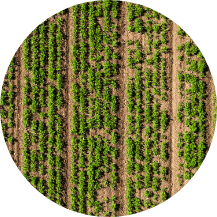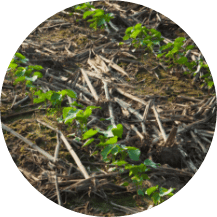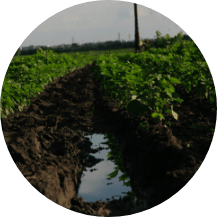
10-Year U.S. Cotton Sustainability Goals
Cotton agriculture around the world has evolved dramatically in recent years. In the U.S. in particular, the commitment to innovation and continuous improvement has led to significant reductions in the water, land and energy needed to produce cotton, and decreased soil loss and greenhouse gas emissions – all while increasing crop yields.
In line with the United Nations’ Sustainable Development Goals, and grounded in science-based evaluation, the U.S. cotton industry has established a set of goals to achieve within the 10 years between 2015 and 2025, to further improve cotton sustainability and lead the world in responsible cotton production. These goals include:

Carbon by
30%

Use Efficiency by 13%

Gas Emissions by 39%
Like other plants, cotton captures carbon dioxide from the atmosphere and uses it to grow. But, cotton also requires nutrients to grow, and the production and use of fertilizers like synthetic nitrogen releases greenhouse gases into the environment. Cotton growers are working with researchers to decrease the amount of fertilizers needed to produce cotton, using technologies that identify the precise amount of nitrogen needed to optimize cotton growth.

Loss per Acre by 50%

Water Use by
18%

Energy Use by
15%
The process to develop these goals followed the Framework for Sustainable Agriculture standard S629 recently adopted by the American Society of Agricultural and Biological Engineers (ASABE). Leaders from U.S. cotton industry organizations, including the National Cotton Council, Cotton Board, Cotton Council International, and Cotton Incorporated engaged a body of experts in cotton biology and production to explore how future technologies would impact trends across 14 key performance indicators used to assess the sustainability of cotton production systems. A further survey of more than 50 cotton producers gathered perceptions of future opportunities and challenges and provided additional context in the formation of these goals.
These conversations resulted in six science-based U.S. cotton industry goals that were presented to the newly formed U.S. cotton sustainability task force, as well as a seventh goal of enrolling 2.5 million additional acres in the Fieldprint® Calculator, a tool that measures progress against environmental KPIs. Each of these goals has five, ten, and 30-year milestones (ten-year milestones are reflected on this page) that range from tactical in the near term to aspirational in the future.
Pathways to Progress: Setting Sustainability Goals
- Daystar, J. S., Barnes, E., Hake, K., & Kurtz, R. (2017). Sustainability trends and natural resources use in U.S. cotton production. BioResources, 12(1), 362–392. https://bioresources.cnr.ncsu.edu/resources/sustainability-trends-and-natural-resource-use-in-u-s-cotton-production/.